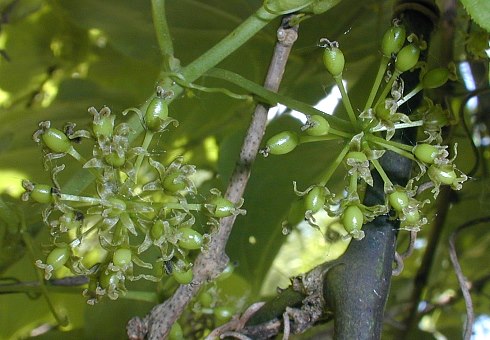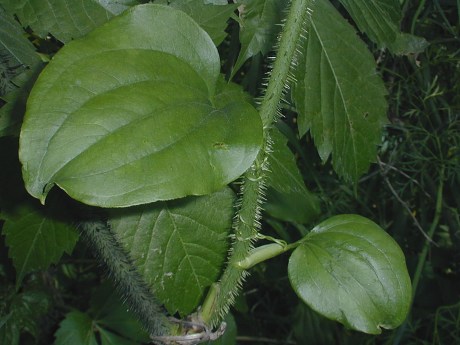Description: This woody vine is up to 10-20' long; it climbs over adjacent shrubs or the lower branches of trees using tendrils. The woody stems are mostly green and round; lower stems are heavily armed with stout straight spines and stiff bristles, while upper stems have few, if any, spines. These spines and bristles become dark brown or black with age. The alternate leaves are up to 5" long and 4" across; they are oval to broadly ovate, smooth along the margins, and hairless. Their margins may have minute teeth, but this is easier to see with a 10x hand lens. Each leaf has 3-7 parallel veins; its upper surface is green, while the lower surface is light green (but not glaucous). At the base of each leaf, there is a slender petiole and a pair of curly tendrils. These tendrils are initially green, but they later become rather stiff and brown.

Occasionally, individual umbels of flowers will be produced from the axils of the upper leaves. The peduncles (stalks) of these umbels are longer than the petioles of the leaves. Each umbel has 8-30 flowers and spans about 2-3" across. Because Smilax spp. are dioecious, a vine will produce either all staminate flowers or all pistillate flowers; perfect flowers are rarely produced. Each staminate (male) flower is about ¼" across; it consists of 6 yellowish or greyish green tepals and 6 stamens. Each pistillate (female) flower is about ¼" across; it consists of 6 yellowish or greyish green tepals, a single ovary, and a short tripartite style. The ovary is ovoid, shiny, and green. The blooming period occurs from late spring to early summer and lasts about 2 weeks. There is no noticeable floral scent. The staminate flowers quickly wither away after blooming. The pistillate flowers develop into fleshy berries. Each berry is about ¼" across, dark blue or black, and contains 1-3 seeds. The leaves are deciduous and fall to the ground during the fall. The root system has short stout rhizomes. This woody vine spreads vegetatively by rhizomes or by reseeding itself.
Cultivation: The preference is light shade to partial sun, moist to mesic conditions, and a fertile loamy soil.
Range & Habitat: The native Bristly Greenbrier is a common woody vine that has been observed in nearly all counties of Illinois (see Distribution Map); it probably occurs in the remaining counties as well. Habitats include moist to mesic woodlands, openings in wooded areas, woodland borders, thickets, and powerline clearances in wooded areas.

Faunal Associations: Various insects, especially small bees and flies, visit the flowers for nectar or pollen. These floral visitors include cuckoo bees (Nomada spp., Sphecodes spp.), Halictid bees (mostly Lasioglossum spp.), Andrenid bees (Andrena spp.), other miscellaenous bees, Eumenine wasps, other miscellaneous wasps, a mosquito species (Aedes stimulans), flower flies (Syrphidae), blow flies (Calliphoridae), flesh flies (Sarcophagidae), lance flies (Lonchaeidae), and other miscellaneous flies (Robertson, 1929; Graenicher, 1902). Insects that feed destructively on these vines include a flea beetle (Pachyonychus paradoxus), larvae of gall flies (Cecidomyiidae), the Woolly Maple Aphid (Neoprociphilus aceris), larvae of the Smilax Stem Gall Wasp (Diastrophus smilacis), and various moths, including the Curve-lined Owlet (Phyprosopus callitrichoides), Spotted Phosphila (Phosphila miselioides), Smilax Leafminer Moth (Marmara smilacisella), and Inimical Borer Moth (Pseudogalleria inimicella). The Insect Table provides a more complete list of this latter group of insects. The fruits of woody Greenbrier vines (Smilax spp.), and to a lesser extent herbaceous Carrion Flower vines (also Smilax spp.), are eaten by many species of birds. These bird species include the Northern Cardinal, American Crow, Fox Sparrow, Gray Catbird, Ruffed Grouse, Pileated Woodpecker, Northern Flicker, Hermit Thrush, Grey-cheeked Thrush, American Robin, and many others. Some of these birds also use these vines for protective cover and nesting habitat (the Bird Table provides more information about these relationships). A bird species that is possibly extinct, Bachman's Warbler, often relied on woody greenbrier vines to provide cover and concealment of their nests in thickets of Giant Cane (Hooper & Hamel, 1977). Mammals that use these vines as a source of food include the White-tailed Deer (leaves, stems), Cottontail Rabbit (woody branches), Virginia Opossum (fruits), Raccoon (fruits), Fox Squirrel (fruits), and American Black Bear (fruits); see Martin et al. (1951/1961) and Haugen (1942).
Photographic Location: Underneath a tree near a powerline clearance at Busey Woods in Urbana, Illinois.
Comments: The species in the Smilax genus fall into two groups: woody vines with thorns, and herbaceous vines or shrubs without spines. Bristly Greenbrier is a typical example of the former group, except that it is more ferociously armed than most Greenbriers. Species in the latter group are called Carrion Flowers. Greenbriers are unusual among woody vines because their branches are green, even during the winter. Bristly Greenbrier can be distinguished from other Greenbriers by the stout straight spines and stiff bristles on its lower branches. Other Greenbriers in Illinois have stout curved spines without stiff bristles, and they are restricted to the southern part of the state. Sometimes Bristly Greenbrier is referred to by the scientific name Smilax tamnoides hispida.